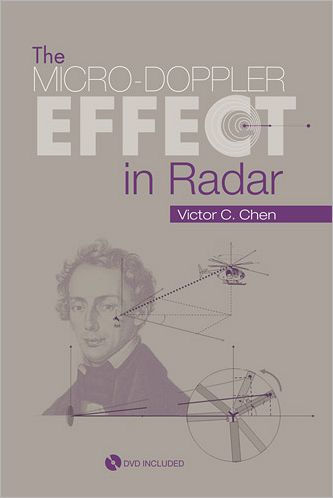Table of Contents
Preface xi
1 Introduction 1
1.1 Doppler Effect 2
1.2 Relativistic Doppler Effect and Time Dilation 4
1.3 Doppler Effect Observed in Radar 7
1.4 Estimation and Analysis of Doppler Frequency Shifts 10
1.5 Cramer-Rao Bound of the Doppler Frequency Estimation 17
1.6 The Micro-Doppler Effect 18
1.7 Micro-Doppler Effect Observed in Radar 20
1.8 Estimation and Analysis of Micro-Doppler Frequency Shifts 20
1.8.1 Instantaneous Frequency Analysis 21
1.8.2 Joint Time-Frequency Analysis 23
1.9 The Micro-Doppler Signature of Objects 26
References 28
Appendix 1A 32
MATLAB Source Codes 32
2 Basics of the Micro-Doppler Effect in Radar 35
2.1 Rigid Body Motion 35
2.1.1 Euler Angles 36
2.1.2 Quaternion 42
2.1.3 Equations of Motion 44
2.2 Nonrigid Body Motion 47
2.3 Electromagnetic Scattering from a Body with Motion 50
2.3.1 Radar Cross Section of a Target 50
2.3.2 RCS Prediction Methods 53
2.3.3 EM Scattering from a Body with Motion 54
2.4 Basic Mathematics for Calculating the Micro-Doppler Effect 56
2.4.1 Micro-Doppler Induced by a Target with Micro Motion 56
2.4.2 Vibration-Induced Micro-Doppler Shift 60
2.4.3 Rotation-Induced Micro-Doppler Shift 63
2.4.4 Coning Motion-Induced Micro-Doppler Shift 66
2.5 Bistatic Micro-Doppler Effect 71
2.6 Multistatic Micro-Doppler Effect 77
2.7 Cramer-Rao Bound of the Micro-Doppler Estimation 79
References 79
Appendix 2A 81
Appendix 2B 83
MATLAB Source Codes 83
3 The Micro-Doppler Effect of the Rigid Body Motion 93
3.1 Pendulum Oscillation 94
3.1.1 Modeling Nonlinear Motion Dynamic of a Pendulum 95
3.1.2 Modeling RCS of a Pendulum 101
3.1.3 Radar Backscattering from an Oscillating Pendulum 102
3.1.4 Micro-Doppler Signatures Generated by an Oscillating Pendulum 105
3.2 Helicopter Rotor Blades 105
3.2.1 Mathematic Model of Rotating Rotor Blades 107
3.2.2 RCS Model of Rotating Rotor Blades 112
3.2.3 PO Facet Prediction Model 114
3.2.4 Radar Backscattering from Rotor Blades 116
3.2.5 Micro-Doppler Signatures of Rotor Blades 120
3.2.6 Required Minimum PRF 123
3.2.7 Analysis and Interpretation of the Micro-Doppler Signature of Rotor Blades 123
3.3 Spinning Symmetric Top 127
3.3.1 Force-Free Rotation of a Symmetric Top 130
3.3.2 Torque-Induced Rotation of a Symmetric Top 132
3.3.3 RCS Model of a Symmetric Top 133
3.3.4 Radar Backscattering from a Symmetric Top 135
3.3.5 Micro-Doppler Signatures Generated by a Precession Top 136
3.3.6 Analysis and Interpretation of the Micro-Doppler Signature of a Precession Top 136
3.4 Wind Turbines 139
3.4.1 Micro-Doppler Signatures of Wind Turbines 140
3.4.2 Analysis and Interpretation of the Micro-Doppler Signature of Wind Turbines 140
References 141
Appendix 3A 143
MATLAB Source Codes 143
4 The Micro-Doppler Effect of the Nonrigid Body Motion 157
4.1 Human Body Articulated Motion 159
4.1.1 Human Walking 159
4.1.2 Description of the Periodic Motion of Human Walking 161
4.1.3 Simulation of Human Movements 162
4.1.4 Human Body Segment Parameters 162
4.1.5 Human Walking Model Derived from Empirical Mathematical Parameterizations 164
4.1.6 Capturing Human Motion Kinematic Parameters 177
4.1.7 Three-Dimensional Kinematic Data Collection 182
4.1.8 Characteristics of Angular Kinematics Using the Angle-Cyclogram Pattern 184
4.1.9 Radar Backscattering from a Walking Human 184
4.1.10 Human Movement Data Processing 187
4.1.11 Human Movement-Induced Radar Micro-Doppler Signatures 189
4.2 Bird Wing Flapping 194
4.2.1 Bird Wing Flapping Kinematics 195
4.2.2 Doppler Observations of the Bird Wing Flapping 198
4.2.3 Simulation of the Bird Wing Flapping 199
4.3 Quadrupedal Animal Motion 202
4.3.1 Modeling of Quadrupedal Locomotion 204
4.3.2 Micro-Doppler Signatures of Quadrupedal Locomotion 205
4.3.3 Summary 205
References 207
Appendix 4A 209
MATLAB Source Codes 209
Appendix 4B 238
MATLAB Source Codes 238
5 Analysis and Interpretation of Micro-Doppler Signatures 247
5.1 Biological Motion Perception 248
5.2 Decomposition of Biological Motion 250
5.2.1 Statistics-Based Decomposition 251
5.2.2 Decomposition of Micro-Doppler Signatures in the Joint Time-Frequency Domain 251
5.2.3 Physical Component-Based Decomposition 252
5.3 Extraction of Features from Micro-Doppler Signatures 256
5.4 Estimation of Kinematic Parameters from Micro-Doppler Signatures 257
5.5 Identifying Human Movements 262
5.5.1 Features Used for Identifying Human Movements 263
5.5.2 Anomalous Human Behavior 264
5.5.3 Summary 266
References 267
6 Summary, Challenges, and Perspectives 271
6.1 Summary 271
6.2 Challenges 272
6.2.1 Decomposing Micro-Doppler Signatures 273
6.2.2 Feature Extraction and Target Identification Based on Micro-Doppler Signatures 273
6.3 Perspectives 275
6.3.1 Multistatic Micro-Doppler Analysis 275
6.3.2 Micro-Doppler Signature-Based Classification 276
6.3.3 Aural Methods for Micro-Doppler-Based Discrimination 276
6.3.4 Through-the-Wall Micro-Doppler Signatures 277
References 278
About the Author 281
Index 283



